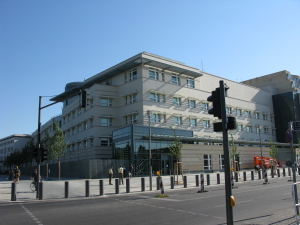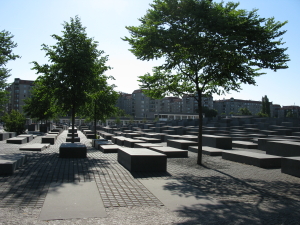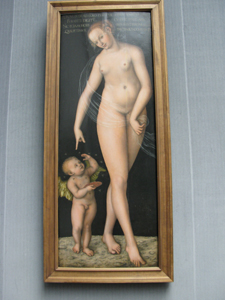 Brandenburg Gate sculpture
This would be our last day in Berlin. We knew how much more we wanted to see and do before we could fully
comprehend this city, but we were pleased to have planned a very full final day.
Brandenburg Gate sculpture
This would be our last day in Berlin. We knew how much more we wanted to see and do before we could fully
comprehend this city, but we were pleased to have planned a very full final day.
 Brandenburg Gate sculpture
This would be our last day in Berlin. We knew how much more we wanted to see and do before we could fully
comprehend this city, but we were pleased to have planned a very full final day.
Brandenburg Gate sculpture
This would be our last day in Berlin. We knew how much more we wanted to see and do before we could fully
comprehend this city, but we were pleased to have planned a very full final day.
We took the S-Bahn to the Brandenburg Gate, where cleanup from the big soccer game gathering was still underway. The new American Embassy, which opened July 4, is a block away. This is the high rent district for embassies; the French and British buildings are on the same block. Of the major nations, the United States was the last to have its embassy completed, after many delays caused by budget problems, Congressional bickering, controversies over the design, and other predictable problems.
 The U.S. Embassy
Across the street from our embassy is a memorial to the Holocaust, a collection of 2711 stelae of differing
heights and sizes, places on an undulating ground. The designer chose not to use any symbolism except for the
metaphor of uncertainty and dislocation -- in this, it is strikingly similar to the Memorial Tower in the Jewish
Museum.
The U.S. Embassy
Across the street from our embassy is a memorial to the Holocaust, a collection of 2711 stelae of differing
heights and sizes, places on an undulating ground. The designer chose not to use any symbolism except for the
metaphor of uncertainty and dislocation -- in this, it is strikingly similar to the Memorial Tower in the Jewish
Museum.
From the memorial we walked along a street holding buildings of the different states of Germany -- e.g., Mitte, Hesse, Bavaria. Since Germany is a federation, these states have much more power in the running of the country than do our 50 states.
 Holocaust Memorial
Our major destination lay just ahead. Just off Potsdamer Platz, the Sony Center is a dazzling confection of glass and steel, with a
floating umbrella above a central atrium. On the spot was a famous hotel, thoroughly bombed, but its one remaining
sumptuous room remains as an elegant restaurant within the Sony Center, linking the old and new Berlin.
Holocaust Memorial
Our major destination lay just ahead. Just off Potsdamer Platz, the Sony Center is a dazzling confection of glass and steel, with a
floating umbrella above a central atrium. On the spot was a famous hotel, thoroughly bombed, but its one remaining
sumptuous room remains as an elegant restaurant within the Sony Center, linking the old and new Berlin.
We spent the time till our late lunch at the Film Museum. We began with the first of the great German films,
including The Cabinet of Dr. Caligari (a model of the set was included, so that we could see where the camera
 The Sony Center
was located and how the actors moved) and Metropolis, as well as much more material about Fritz Lange, perhaps
Germany's first major director. We could have spent the entire day there, watching movie clips, admiring Marlene
Dietrich's costumes and luggage, discovering how many Hollywood stars started their careers in German movies. We moved from
room to room, each one different in design -- sometimes films to watch, in one room a wall full of drawers,
The Sony Center
was located and how the actors moved) and Metropolis, as well as much more material about Fritz Lange, perhaps
Germany's first major director. We could have spent the entire day there, watching movie clips, admiring Marlene
Dietrich's costumes and luggage, discovering how many Hollywood stars started their careers in German movies. We moved from
room to room, each one different in design -- sometimes films to watch, in one room a wall full of drawers,
 Venus and Cupid by Cranach
each containing interesting objects. We wore headsets for English-language audio guides and indeed, many of the
captions were in German and English. The adjoining TV museum was aimed strictly at those fluent in German.
Venus and Cupid by Cranach
each containing interesting objects. We wore headsets for English-language audio guides and indeed, many of the
captions were in German and English. The adjoining TV museum was aimed strictly at those fluent in German.
After lunch at an Australian-style cafe (we opted out of crocodile and kangaroo meat) we walked to the Kulturforum, a rather stark modern multiple-use gallery which included the Gemaldegalerie (Picture Gallery). This is a marvelous collection of paintings from the 13th to the 18th century. We saw works by Cranach, Durer, Bosch and Rembrandt as well as some English artists. Once again we had excellent English-language audioguides. The number and breadth of art museums in Berlin alone is staggering. We visited less than half of the major museums in the city, each of which hold collections which would be the envy of many large cities in Europe and the United States.
By now we were thoroughly exhausted, and well aware that our time in Europe was drawing to a close. The following day we returned by train to Brussels, where we stopped at a forgettable motel near the train station overnight, then, the following morning, we took the train to the airport and the airplane home.